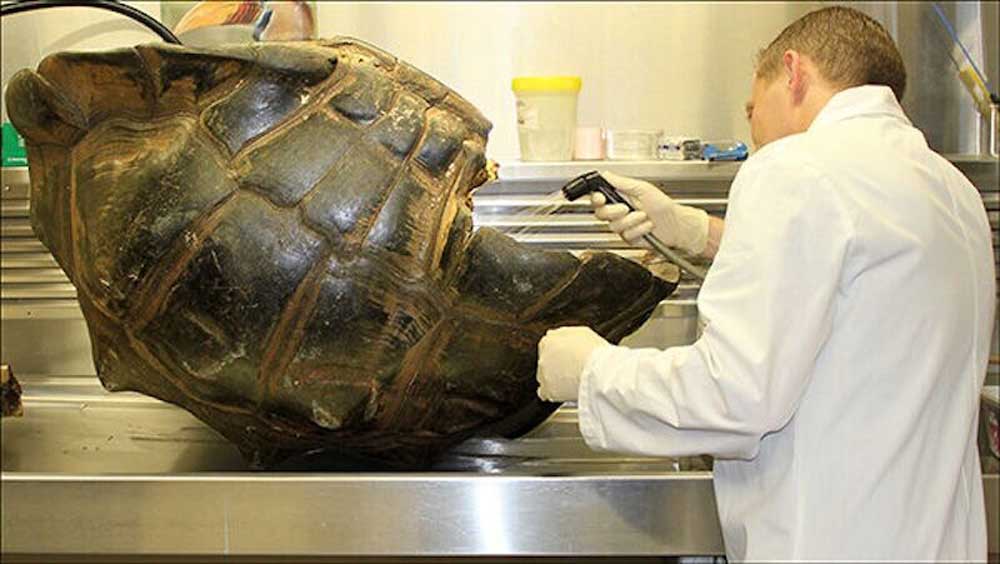National Fish and Wildlife Forensics Lab marks 25 years of solving crimes in the wild
Published 10:00 am Sunday, September 1, 2024

- Johnnie French, morphology collections manager at the National Fish and Wildlife Forensics Laboratory, cleans out a giant tortoise shell.
Celebrating its 25th anniversary, the Clark R. Bavin National Fish and Wildlife Forensics Laboratory on East Main Street in Ashland remains the world’s only full-service wildlife crime lab, not only solving high-profile cases, but in many ways changing the game for wildlife crime.
Trending
Founded in 1988, and dedicated in 1989 as the Clark R. Bavin National Fish and Wildlife Forensics Laboratory, the lab investigates around 800 to 1,000 wildlife crimes for the United States and foreign nations, said lab director Ken Goddard. Goddard has been with the lab since its beginning.
Wildlife crime, which includes poaching, trafficking and breeding of endangered species, poses immense threats to biodiversity on local and global scales, according to CITES, the Convention on International Trade in Endangered Species of Wild Fauna and Flora.
Cases reach worldwide
In the U.S. alone, illegal trade in wildlife is worth an estimated $20 billion annually, according to Interpol.
“We’re helping to save wildlife around the world,” Goddard said.
Illegal trade in wildlife has gone through fads throughout the lab’s 25 years, said Ed Espinoza, criminalistics section chief.
“We see, over time, these trends in which, all of a sudden, people are making tons of money, and then a bunch of people get arrested,” Espinoza said. “Whatever happens, it stops, and then we move on to the next thing.”
For years, ivory was the thing to trade, then bear gallbladder for its bile and then caviar from Russia.
“Five or six DNA experts, for, I think (for) four years, (were) doing nothing but just overwhelmed” with caviar, Goddard said. “And that finally stopped, and, you know, it’s just, we never know what’s coming.”
Branching into wood
Currently, Espinoza said, timber is what’s keeping them busy. The animal investigators got involved with the plant kingdom when they took on timber cases following Fish and Wildlife raids of Gibson Guitars.
In 2009 and 2011, two Gibson warehouses in Tennessee were raided by federal agents who seized Brazilian rosewood and Indian ebony wood. Both are listed as endangered and illegal to import into the country.
“Our agents raided the place, seized the illegal materials, or what they thought was illegal, called me up, said, ‘So you guys can identify rosewood, right?’ I said, ‘No, we’re bunnies and guppies. We don’t do wood,’” Goddard said.
However, they still had to confirm if the seized wood was endangered rosewood and ebony.
“Ed found out each species of wood, even if it’s made into two-by-fours, has its own collection of oils, different oils that will evaporate,” Goddard said.
Now, they have what Goddard refers to as their “woodshop,” a room dedicated only to wood specimens.
In 2012, Gibson was assessed a penalty of $300,000 for criminal violation of the Lacey Act, which protects against trafficking of illegal plants and animals.
Tigers and butterflies
Other cases the lab has been involved with include the infamous Netflix “Tiger King” docuseries and a case necessitating going undercover for endangered butterflies.
In 2021, the United States seized 68 big cats, including lions, tigers, tiger-lions and a jaguar from Tiger King Park in Oklahoma for violation of the Endangered Species Act. Several of the show’s stars would later be charged with violating the ESA and the Lacey Act following investigations from the lab.
Hisayoshi Kojima, a notorious butterfly smuggler, was charged with 17 felonies for the smuggling and selling of several endangered butterfly species, including the giant swallowtail butterfly and a pair of Queen Alexandra’s birdwing butterflies. The charges came in 2007 after Ed Newcover, a USFWS special agent, went undercover for three years to lure Kojima from Japan to the U.S., where he was eventually arrested.
The Queen Alexandra’s birdwing butterflies are now held in the lab’s morphology collection.
Like a regular police crime lab, the wildlife forensics laboratory works to link evidence to crime, to suspect, to victim. Most often, this means determining the cause of the animal’s demise.
Identifying the victim
Unlike the police, however, the lab often has to first figure out what exactly the crime’s victim is — the animal (or plant).
“If we have a whole elephant, pretty obvious,” Goddard said. “If we have strips of skin, chunks of meat, hair or feathers, it’s not obvious what our victim is.”
To determine the species, the lab has two main choices: DNA analysis or morphology, the comparison of the victim to the lab’s specimens collection.
In situations where all the investigators have of the victim is blood, tissue, bone or ivory, DNA analysis is the best option. They have three labs dedicated solely to DNA analysis.
The standard is DNA sequencing — figuring out the identifiable pairs of A’s, T’s, G’s and C’s that make up the DNA of a species. New technology, however, is on the horizon.
“They’re $200,000 instruments, and they’re about to be obsolete,” Goddard said.
The lab recently received a machine costing $150,000 that maps out the entire genome, the complete set of genetic material that makes up a species.
“We put a sample of wolf blood in the genomic machine (and) it generated a terabyte of data.” Goddard said. “Our computers crashed. We weren’t used to that.”
The technology is still in its infancy, so for the time being, the lab primarily uses genetic sequencing.
A vast collection
If given more than just blood or tissue, the lab makes use of its massive specimens collection.
Run by morphology collections manager Johnnie French, the warehouse is only a recent addition to the lab. Before it opened five years ago, everything was stored in boxes, making the process tedious.
“Our morphology section makes us really unique,” Goddard said. “Everything else, you know, genetics, evidence handling, pathology, is done by other labs as well. But nobody has Johnnie.”
Their morphology collection has made the lab the official lab for CITES, meaning it services all 183 countries that signed the treaty.
In the lab’s early days, the staff relied almost exclusively on a modest library of reference books to determine a victim’s species.
“This is also a library, only this is a library of dead things,” French said. “We don’t have any question that we have to go back to the literature.”
Row after row of sheep, goat and deer busts hang on the walls. On the tables lay tiny, white intricate ivory statues. Along the middle rows, carts are filled with alligator skin purses (with the alligator’s head still intact), boots and heels.
Roughly 100,000 specimens are stored in this building, and the collection is always growing.
“Normal museums, like the Smithsonian or the American (Museum of Natural History in New York), they’ll go out and actually kill specimens,” French said. “We don’t do that. We rely on donations.”
Many of their donations come from zoos or closing museums. Sometimes taxidermied animals were donated from museums because they had slight imperfections, meaning museums couldn’t display them, French said.
3D printed replicas
The lab is working on making 3D printed versions of specimens requested by other forensics labs.
“People want to borrow from our collection,” Goddard said. “We really don’t want to lend stuff out.”
After the species is identified and cause of death uncovered via a necropsy (autopsy on a nonhuman), lab experts testify in court. Typically, only 3% to 5% of the cases actually go to trial. Most defendants plead out, according to Goddard.
“If we’re gonna put somebody in jail and prison, seize their property or whatever, based on our evidence that we present to the court, we have to be right,” Goddard said.
Goddard said they haven’t lost a case yet, something he chalks up to the immense amount of effort they put into their reports.
“I can’t do a day,” Goddard said, “(where) I haven’t come home and something different or strange hasn’t happened.”









